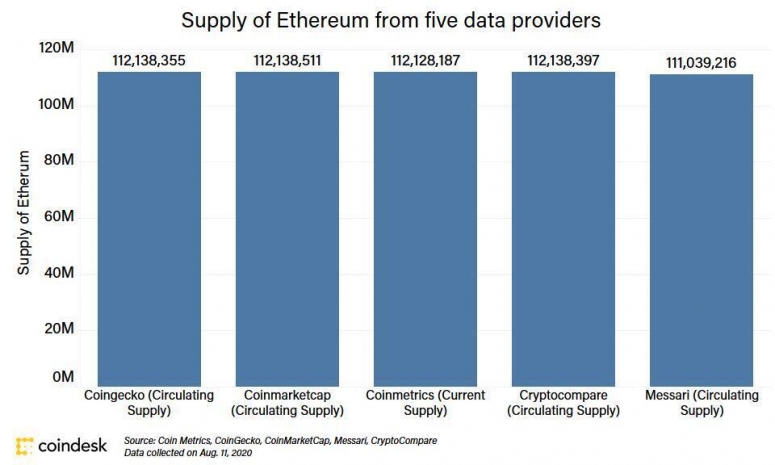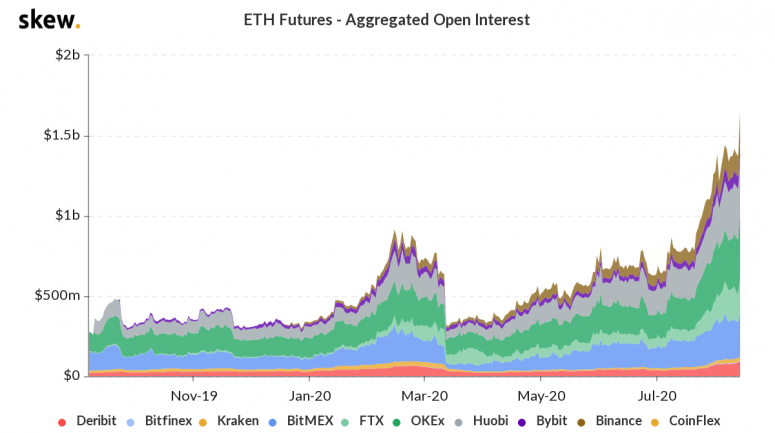Every epic tale needs a tragic hero, and one of the top candidates for that role in this century’s dramatic passage so far has to be the hedge fund manager. Toppled from their masters-of-the-universe pedestal in the early 2000s, they now eke out meager gains, dodge investor recriminations about fees and occasionally attempt to stay relevant by explaining to the rest of us where the current confusion is taking the global economy. True, there are some formidable brains and admirable initiatives among the former kings of finance. But so far, after a promising legacy and the occasional shining moment, this has not been their decade.
This week Eurekahedge, which monitors industry health through a series of hedge fund indexes, reported average performance for July of 2.6%, and a year-to-date return of 1.7%. This significantly underperformed the S&P 500 (+4.7% for the month), Nasdaq Composite (+5.3%), gold (+10.3%), bonds (the long bond TLT index is up 4.4%) and, of course, bitcoin (+22%). The underperformance year-to-date follows a similar pattern.
But here’s an interesting twist: The Eurekahedge Crypto-Currency Hedge Fund Index was up 21% in July, and 50% over the first seven months of 2020. That’s a nice performance. But aren’t hedge funds supposed to outperform the industry benchmark? The YTD performance of bitcoin to the end of July is 55% – in other words, the leading cryptocurrency by market cap outperformed crypto-focused hedge funds by five basis points, or 10%.
You’re reading Crypto Long & Short, a newsletter that looks closely at the forces driving cryptocurrency markets. Authored by CoinDesk’s head of research, Noelle Acheson, it goes out every Sunday and offers a recap of the week – with insights and analysis – from a professional investor’s point of view. You can subscribe here.
In hedge fund terms, that’s significant, not least because one of the main points of hedge funds is to take extra risk, get extra return and make benchmarks look boring.
So, is the story here the outperformance of crypto hedge funds compared to their traditional brethren? Or is it the underperformance of crypto hedge funds compared to the industry’s benchmark?
I think it’s the former, that crypto funds are outperforming non-crypto funds, a trend that is likely to continue given evolving market developments and sentiment.
The relative underperformance to bitcoin (and even more so to other crypto assets such as ether) does not dim the prospects for crypto hedge funds going forward.
Investing in a crypto hedge fund instead of directly in the market is going to be a more attractive option for many investors even if the returns are slightly lower, because using a vehicle run by seasoned management is probably safer than direct market participation. Investors don’t have to worry about custody, best execution and liquidity crunches.
And some recent developments point to more favorable tailwinds for crypto hedge funds as the year progresses.
Visibility
First, we have growing awareness of crypto as an asset group. Mentions of bitcoin in the press got a bump with the halving in May, and have remained high since, as this chart from The TIE shows:
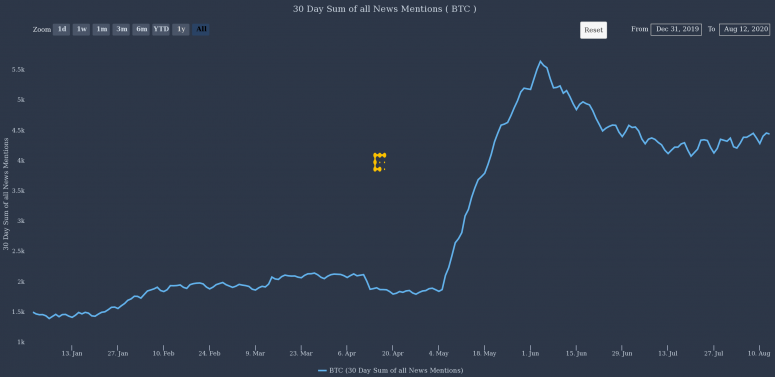

This exposure is likely to intensify over the coming weeks as inflation concerns spread. This week, listed business intelligence firm MicroStrategy chose to invest half of its $500 million of excess treasury in bitcoin, as an inflation hedge.
Also, this past week Grayscale Investments* launched a TV ad that positions cryptocurrency as a natural evolution of money, and investment house Galaxy Digital took out a full page ad featuring bitcoin in big letters in the Financial Times. For an audience growing increasingly uneasy about monetary policy, price pressures and market fundamentals, these are hard to miss.
Volatility
Second, volatility is back. In the case of bitcoin, volatility was until recently trending sharply down from “typical” levels. While still lower than its 2019 average, the metric has turned upward again.


This may deter some investors, but hedge funds typically seek out volatility. Its return could entice more mainstream hedge funds to set up a crypto arm. According to a report in the Financial Times this week, some “blue-chip” names are looking to do just that.
What’s more, until recently, correlations among crypto assets were relatively high. By betting on bitcoin, you could with one investment pretty much count on a large part of the market’s performance.
Over the past few weeks, however, correlations have fallen, and given the growing attention on individual projects emerging in decentralized finance and other applications, this trend is likely to continue.
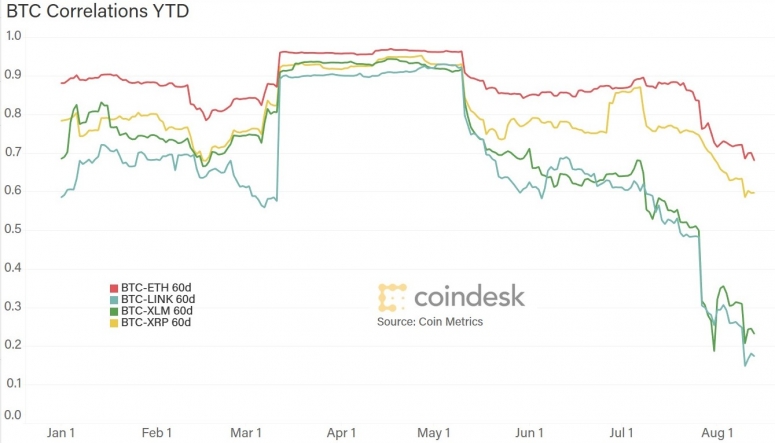

That makes the case for professionally managed crypto portfolios even more compelling, as outperforming the industry’s benchmark becomes a more creative challenge when active asset selection has a greater chance of delivering less correlated returns.
Support
And third, the growing operational support for professional crypto investing is also an encouraging factor.
Institutional-grade prime brokerage services for crypto investors are still in their infancy, but some big names with sizeable balance sheets and professional street cred have entered the space. And some finance giants such as Goldman Sachs and Fidelity seem to be carefully moving towards offering similar services.
When names that hedge funds are already familiar with start to offer support for crypto investments, we are likely to see even more traditional hedge funds try the crypto market on for size.
Furthermore, July’s statement from the Office of the Comptroller of the Currency that banks can now custody crypto assets is another strong step forward in getting hedge funds comfortable with the asset class. Public comments submitted by industry participants, including banks, think tanks and crypto companies, indicate an interest but also a need for further clarification. As this clarification emerges over the coming months and years, we are likely to see first a trickle and then a flood of traditional financial institutions eager to cater to those hedge fund clients that are becoming active in crypto markets. And in a virtuous circle, any type of service that reduces settlement and trading friction is likely to boost hedge fund interest.
Redemption
Are these trends enough to restore the hedge fund manager to his or her former glory? Will crypto hedge fund managers become the new kings of the market? It’s unlikely, at least not in the same money-to-burn way.
With markets undergoing a profound transformation in their underlying philosophy and with fundamentals no longer a driving force in valuations, beating the market no longer has the same intellectual cachet that it had in previous decades.
Yet there is still cachet in spotting winning trends before the mainstream, and in being insightful and brave enough to back nascent technologies.
The redeemed hero of the 21st century may end up being a hedge fund manager after all – only the heroics will not just be based on wealth. They will be based on the courage to see beyond the typical manager’s toolbox, to acknowledge one’s own limitations when it comes to understanding finance, and to understand that change can be harnessed for good.
(*Grayscale Investments is part of DCG, also parent of CoinDesk.)
Supply misunderstandings
Crypto land is never short on drama. One of the many attention-grabbers this past week was what has become known as “supplygate,” in which it was revealed that there is no agreement on what the actual supply of ether (ETH) is. It turns out that different data aggregators display different amounts.
For some, this is a clear example of Bitcoin’s superior transparency, and even calls into question whether Ethereum works as a ledger. In my opinion, the comparison is pointless. Total supply is important, even if only for the purposes of calculating market cap, which in turn affects some crypto indices.
Also, there are genuine concerns that the lack of clear idea of the supply does make the network vulnerable to an “inflation bug,” in which a code error mines additional tokens. If you don’t know what the supply is, how do you know if it’s not what it should be?
Yet, the consternation is especially interesting for what it says about the different value propositions of bitcoin and ether.
To start with, while both Bitcoin and Ethereum run on proof-of-work blockchains, there are stark differences in how supply is issued and calculated. I’m not going to wade into the details here, but it helps to understand that Bitcoin has a relatively simple protocol-level method to get the current supply, while Ethereum has some technical differences that make extracting exact balances a lot more complicated and time-consuming. And with the ether issuance changing every 15 seconds or so, latency further complicates the attempt.
Even more significant is the value proposition of each. Bitcoin’s hard cap of 21 million is part of what gives it value. Ethereum doesn’t have an effective hard cap – therefore its exact supply at any given moment is not as relevant. It has never claimed to be a hard money, and while some insist that “ETH is money,” that argument is largely used in the context of the potential of decentralized finance.
To me, all this highlights the uniqueness of the concept of crypto networks. Circulating assets with active developer communities can prioritize different characteristics, which speaks to the innovation and potential disruption, not to mention the unforeseen use cases, of assets that have managed to accrue significant monetary value on the basis of adoption and faith. Long may the dramas rage, especially when they are as educational as this one.
Anyone know what’s going on yet?
In spite of a worrying inflation report, the looming income cliff as a support package agreement is again delayed, and general pessimism regarding the upcoming U.S.-China trade talks, the S&P 500 continued its march upward, almost reaching all-time intraday highs at time of writing on Friday afternoon. European stocks, especially those linked to tourism, took a hit as new lockdown measures were announced in some areas.
There was some positive news on U.S. retail sales (at the cost of the hospitality sector), and U.S. unemployment claims fell below 1 million for the first time since March. But overall, the feeling is that the recovery has stalled in most major economies.


In spite of central bankers actually talking about inflation, gold had a bad week, falling almost 6%. Bitcoin held its ground, falling less than 0.1%, in the face of a bitcoin-gold correlation that has almost surpassed its year-to-date high.
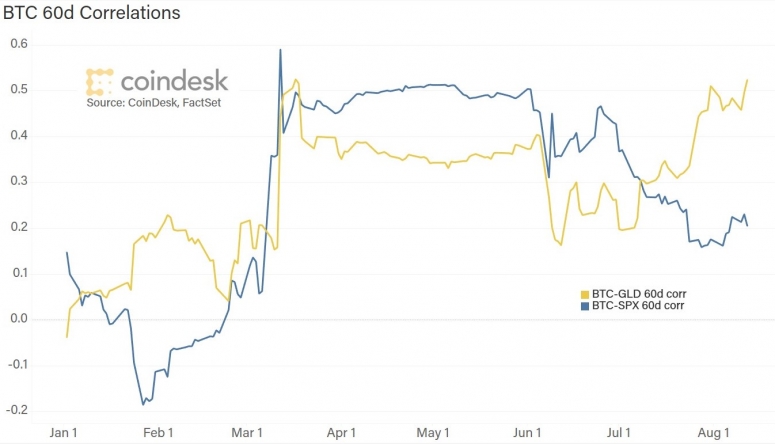

As bitcoin’s correlation to gold heads up, its correlation to the S&P 500 continues to trend down. Could this be yet another narrative twist for the cryptocurrency? Is it now more of a risk-off, digital gold play than it has been for most of the year so far?
CHAIN LINKS
Publicly traded business intelligence firm MicroStrategy put half of its excess treasury into bitcoin, investing approximately $250 million. TAKEAWAY: This is a big deal, not just for the size and not just for the fact that a listed company with over $1 billion in revenue has publicly bet on bitcoin as an inflation hedge. It’s also a big deal for the signal it sends to other companies that inflation might be coming, and that bitcoin is a good hedge. What’s more, the size of the bet turns MicroStrategy into a listed bitcoin play. Since the purchase was disclosed earlier this week in an SEC filing, the stock price has increased by almost 20%, a bump that other companies will take notice of. (As an aside, the CEO Michael Saylor is the author of “The Mobile Wave: How Mobile Intelligence Will Change Everything,” so his conviction about bitcoin is not a shot in the dark.)


Caitlin Long, founder of Avanti Bank, gives more detail on the Avit, a type of commercial bank money or programmable electronic cash, issued on a blockchain. TAKEAWAY: I am fascinated by the emerging subset of bank-issued tokens, as they could become a significant feature of the settlement landscape of the near future, and as such, have a material impact on how markets work. The supply of fiat-backed stablecoins has surged over the past few months, as investors take advantage of the enhanced liquidity they confer. Yet the legal aspect of stablecoin settlement is still unclear. Bank-sponsored tokens, however, could cover that gap, and make settlements more efficient while enhancing market liquidity. Avit takes the stablecoin concept a step further in that it will be an entirely new token, backed by U.S. dollar-based reserves, but not a representation of a real-world asset.
Crypto exchange Coinbase will soon allow U.S. retail customers to borrow fiat loans against their bitcoin holdings. TAKEAWAY: Against the scramble from other big-name firms to get into the business of prime brokerage for institutional investors, this move underscores Coinbase’s retail-first strategy. Although the marketing stresses the efficiency of borrowing against bitcoin holdings for expenditures such as weddings, home renovations, etc. it could end up being used to leverage crypto positions – customers could use their bitcoin to borrow money with which to buy more bitcoin. The leverage is not much – loans are limited to the lesser of $20,000 or 30% of the bitcoin holdings. It is still notable, however, given relative scarcity of leverage opportunities, especially for retail clients on U.S.-based spot exchanges.
Deribit, the largest crypto options exchange, has started listing ether (ETH) options with strikes above $1,000, and some traders are now betting the cryptocurrency will reach that price by year’s end. TAKEAWAY: Trading interest in ETH seems to be gathering steam, as open interest and daily volumes for ETH futures and options are reaching record levels. They are still significantly lower than volumes for bitcoin (BTC) derivatives, but the growth is notable and likely to continue as the Ethereum blockchain continues to move towards a systemic upgrade that will in theory solve scaling and cost issues.
Staying with derivatives, bitcoin futures’ open interest on the CME, often taken as a proxy for institutional participation in the sector, has reached $800 million, up nearly 120% from the July low of $365 million. TAKEAWAY: This makes it the third-largest bitcoin futures exchange in terms of open interest in the world, behind OKEx and BitMEX, and the only one that’s regulated in the U.S. As recently as a month ago, it was in fifth position.
Riot Blockchain and Marathon Patent Group, crypto mining companies listed on Nasdaq, are up over 95% and 125% respectively over the past 12 months, significantly beating bitcoin’s 3% gain. TAKEAWAY: This highlights that crypto assets are not the only way to get exposure to the market. Riot Blockchain’s increase is in spite of Q2 earnings released earlier this week which showed a drop in mining revenue from a year ago. Listed companies also come with additional micro risk, however, and should not be seen as a proxy for the assets themselves. Hut 8, for instance, which announced Q2 earnings this week, has lost almost 50% of its value over the same period.
Jesus Rodriguez points out some of the challenges crypto assets present quant strategies. TAKEAWAY: These include the fact that the datasets are smaller than with traditional assets, with some trading histories counted in months, which makes it hard to build predictive models. Also, the crypto market’s relatively frequent “outlier” events and irregular trading patterns will confuse models. And models are further hampered by the poor quality and reliability of datasets, with many exchanges exhibiting fake volumes, wash trades or spoofing behavior.
Will Foxley reached out to exchanges, traders and funds for more insight into last week’s 51% attacks on the Ethereum Classic network. TAKEAWAY: Some insiders attribute the lack of a price plunge to the highly correlated nature of the smaller cryptocurrencies – others believe it’s because the network fundamentals are unchanged. As I mentioned last week, I believe that it could be because it’s already priced in. ETC has significantly underperformed most crypto assets over just about any recent timeframe.
India’s crypto trade volumes have soared since the Supreme Court of India lifted banking restrictions for exchanges in March, reaching an all-time high in July. TAKEAWAY: Given the sheer size of the potential investing population, India’s attitude towards bitcoin is worth keeping an eye on, as even a moderate uptick could move the market. Also relevant is the country’s experience with demonetization, and its relatively high inflation.
Podcast episodes worth listening to:


